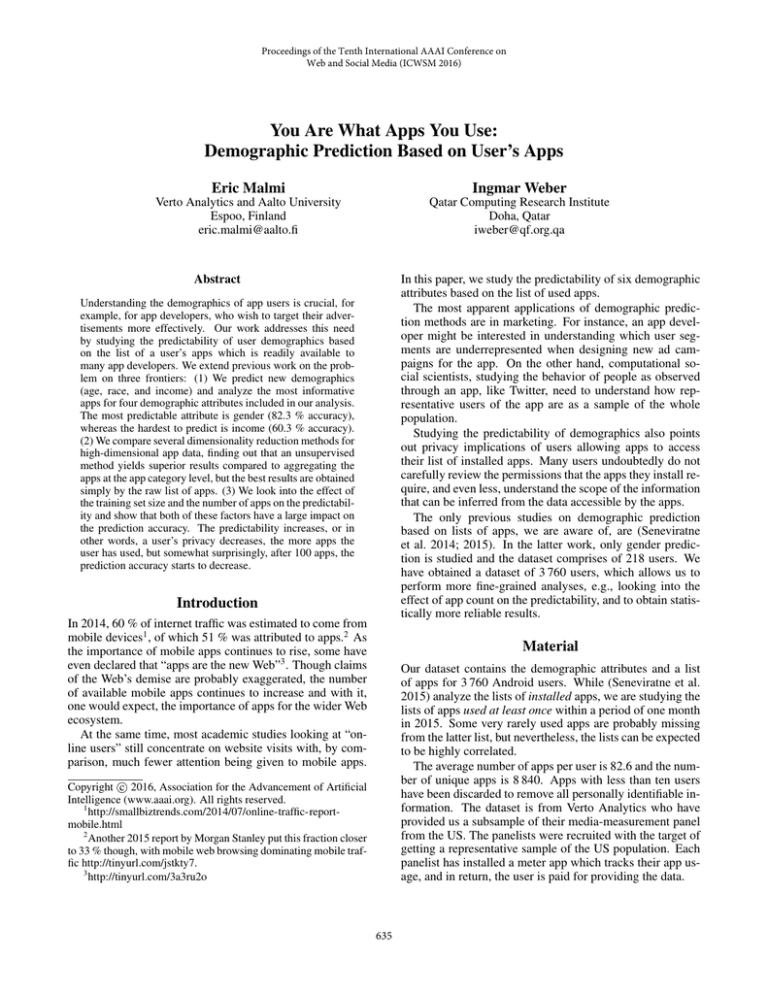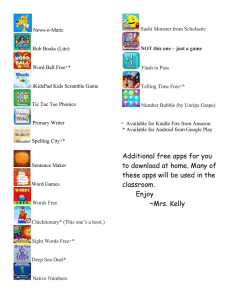
Proceedings of the Tenth International AAAI Conference on
Web and Social Media (ICWSM 2016)
You Are What Apps You Use:
Demographic Prediction Based on User’s Apps
Eric Malmi
Ingmar Weber
Verto Analytics and Aalto University
Espoo, Finland
eric.malmi@aalto.fi
Qatar Computing Research Institute
Doha, Qatar
iweber@qf.org.qa
In this paper, we study the predictability of six demographic
attributes based on the list of used apps.
The most apparent applications of demographic prediction methods are in marketing. For instance, an app developer might be interested in understanding which user segments are underrepresented when designing new ad campaigns for the app. On the other hand, computational social scientists, studying the behavior of people as observed
through an app, like Twitter, need to understand how representative users of the app are as a sample of the whole
population.
Studying the predictability of demographics also points
out privacy implications of users allowing apps to access
their list of installed apps. Many users undoubtedly do not
carefully review the permissions that the apps they install require, and even less, understand the scope of the information
that can be inferred from the data accessible by the apps.
The only previous studies on demographic prediction
based on lists of apps, we are aware of, are (Seneviratne
et al. 2014; 2015). In the latter work, only gender prediction is studied and the dataset comprises of 218 users. We
have obtained a dataset of 3 760 users, which allows us to
perform more fine-grained analyses, e.g., looking into the
effect of app count on the predictability, and to obtain statistically more reliable results.
Abstract
Understanding the demographics of app users is crucial, for
example, for app developers, who wish to target their advertisements more effectively. Our work addresses this need
by studying the predictability of user demographics based
on the list of a user’s apps which is readily available to
many app developers. We extend previous work on the problem on three frontiers: (1) We predict new demographics
(age, race, and income) and analyze the most informative
apps for four demographic attributes included in our analysis.
The most predictable attribute is gender (82.3 % accuracy),
whereas the hardest to predict is income (60.3 % accuracy).
(2) We compare several dimensionality reduction methods for
high-dimensional app data, finding out that an unsupervised
method yields superior results compared to aggregating the
apps at the app category level, but the best results are obtained
simply by the raw list of apps. (3) We look into the effect of
the training set size and the number of apps on the predictability and show that both of these factors have a large impact on
the prediction accuracy. The predictability increases, or in
other words, a user’s privacy decreases, the more apps the
user has used, but somewhat surprisingly, after 100 apps, the
prediction accuracy starts to decrease.
Introduction
In 2014, 60 % of internet traffic was estimated to come from
mobile devices1 , of which 51 % was attributed to apps.2 As
the importance of mobile apps continues to rise, some have
even declared that “apps are the new Web”3 . Though claims
of the Web’s demise are probably exaggerated, the number
of available mobile apps continues to increase and with it,
one would expect, the importance of apps for the wider Web
ecosystem.
At the same time, most academic studies looking at “online users” still concentrate on website visits with, by comparison, much fewer attention being given to mobile apps.
Material
Our dataset contains the demographic attributes and a list
of apps for 3 760 Android users. While (Seneviratne et al.
2015) analyze the lists of installed apps, we are studying the
lists of apps used at least once within a period of one month
in 2015. Some very rarely used apps are probably missing
from the latter list, but nevertheless, the lists can be expected
to be highly correlated.
The average number of apps per user is 82.6 and the number of unique apps is 8 840. Apps with less than ten users
have been discarded to remove all personally identifiable information. The dataset is from Verto Analytics who have
provided us a subsample of their media-measurement panel
from the US. The panelists were recruited with the target of
getting a representative sample of the US population. Each
panelist has installed a meter app which tracks their app usage, and in return, the user is paid for providing the data.
c 2016, Association for the Advancement of Artificial
Copyright Intelligence (www.aaai.org). All rights reserved.
1
http://smallbiztrends.com/2014/07/online-traffic-reportmobile.html
2
Another 2015 report by Morgan Stanley put this fraction closer
to 33 % though, with mobile web browsing dominating mobile traffic http://tinyurl.com/jstkty7.
3
http://tinyurl.com/3a3ru2o
635
Table 1: Demographic prediction accuracy based on a user’s
apps. Classes have been binarized and balanced. AUC
(Web) column shows the prediction performance based on
visited websites from (Goel, Hofman, and Sirer 2012).
Attribute
Classes
Accuracy
AUC
AUC (Web)
Gender
Age
Race
Married
Children
Income
Male vs. Female
18–32 vs. 33–100
White vs. Non-white
Married vs. Single
0 vs. ≥ 1 children
≤ $40K vs. > $40K
82.3 %
77.1 %
72.7 %
72.5 %
63.5 %
60.3 %
0.901
0.850
0.801
0.792
0.688
0.645
0.84
0.85∗
0.83
NA
NA
0.75∗
period tracking apps are good predictors for gender, whereas
dating apps are more informative about the marital status.
How Much Does the Size Matter?
We also study the gender prediction accuracy as a function
of the training set size in Figure 1b. An absolute improvement of more than ten percents can be obtained by increasing the training set size from 100 users to 2 300 users. Error bars show the standard deviations of the accuracies over
100 balanced random subsamples per given number of train
users.
(Seneviratne et al. 2015) report an accuracy of 69.8 % for
a dataset of 174 users, 50 % of which are used for training (their original dataset is 218 users but they undersample the majority class to balance the classes). To be able to
benchmark against this result, we take 300 balanced random
subsamples of 174 users and run 2-fold cross-validation for
these samples. We obtain a comparable average accuracy of
(68±5)% even though we are not using content-based features derived from app descriptions nor numeric features as
done in (Seneviratne et al. 2015). This suggests that the bag–
of–apps features alone can provide a competitive performance. Furthermore, these features can be extracted more
easily, without having an access to an API for scraping the
Google Play store.
A user who has installed a hundred apps probably reveals
more of herself than a user with five apps. Thus it is relevant to ask, how quickly is privacy lost when the number
of apps increases. In Figure 1c, we tackle this question by
binning the users according to the number of apps they have
used and showing the prediction accuracy averaged over all
demographic attributes
of all users in a bin. The standard
errors are given by p(1 − p)/n. The results show that the
accuracy increases by about ten percents going from 20 apps
to 100 apps but after that, somewhat surprisingly, the accuracy starts to decrease. To test whether the decrease is statistically significant, we perform an independent two-sample
t test with the following null hypothesis: “The overall demographic prediction accuracy is not higher for the users
with 50-150 apps compared to the users with more than 150
apps.” We can reject the null hypothesis (p = 0.014), which
shows that using a lot of apps at least once per month actually increases privacy.
Methods
When choosing a suitable prediction method, it is important to consider the following characteristics of the dataset:
(1) feature vectors (bags–of–apps) are binary and very
sparse, (2) the number of features, 8 840, is larger than the
number of datapoints, 3 760, and (3) the dependent variables
(user demographics) can be treated categorical.
Logistic regression is a natural choice for this type of a
problem. We also tested support vector machines with different kernels and random forests, but both the results and
the running times were inferior. While logistic regression
can be adapted to multi-class problems, we instead binarize the demographic variables and balance the classes. This
allows us to compare the predictability of different demographic variables.
Results
Next, we show results related to three different aspects of demographic prediction, namely, (1) the predictability of different demographics, (2) the effects of the training set size
and the number of user’s apps, and (3) the effect of various
dimensionality reduction methods.
How Much is Revealed by Which Apps?
Classification accuracies for six different demographic attributes are shown in Table 1. They are computed based on a
ten-fold cross-validation, and the most predictable attribute
is gender, whereas the household income of a user is the
most difficult to tell based on the list of user’s apps. The results are surprisingly similar to the AUC scores reported by
(Goel, Hofman, and Sirer 2012) who employed visited websites as the features instead of apps. In their work, the attributes marked with ‘*’ had a slightly different binarization
threshold compared to us. The receiver operating characteristic for gender, given in Figure 1a, shows that for half of the
users, the gender can be predicted with a 97 % accuracy.
By studying the coefficients of the logistic model, we can
analyze the contribution of individual apps to the predictions. The coefficients with the largest absolute values are
the most predictive ones. In Table 2, we have listed these
apps for four different demographics along with the coefficients, the shares and the numbers of users who have used
the app4 . Many of the results are not surprising; for instance,
4
Dimensionality Reduction
Due to the high dimensionality of feature vectors (8 840
unique apps) we study three different dimensionality reduction approaches.
The first method, adopted by (Seneviratne et al. 2015),
considers only the apps installed by at least 10 % of the users
(125 apps in total). With this approach the gender prediction
accuracy drops from 82.3 % to 73.6 %, and even with the
dataset of 174 users, the accuracy is decreased from 68 % to
65 %. It is important to use the full list of apps since some
of the apps might be reliable predictors even though they are
rare (think, for example, of a rare period tracking app).
over demographics as some users have been removed when balancing the classes.
Note that for a given app, the number of users, n, might vary
636
Table 2: The most predictive apps for different demographic attributes along with the logistic regression coefficients (Coef),
the fractions of app users with the demographic attribute (Share), and the numbers of app users (n).
Gender (Male)
Age (33–100)
Coef
Share n
0.81
0.73
0.63
0.59
0.56
0.52
0.52
0.49
85 %
80 %
78 %
80 %
86 %
72 %
97 %
84 %
App name
150 ESPN
142 Geek - Smarter Shopping
277 Tinder
172 Fallout Shelter
106 WatchESPN
190 Clash of Clans
41 Grindr - Gay chat, meet & date
96 Yahoo Fantasy Football & More
Income (≥ $50K)
Share n
App name
Coef
Share n
App name
Coef
Share n
App name
0.53
0.48
0.46
0.44
0.43
0.41
0.40
0.40
80 %
53 %
58 %
80 %
60 %
54 %
55 %
92 %
Great Clips Online Check-in
Email
New Words With Friends
BINGO Blitz
iHeartRadio - Music & Radio
Field Agent
Lookout Security & Antivirus
DoubleUCasino
0.55
0.44
0.44
0.44
0.40
0.40
0.38
0.37
67 %
67 %
60 %
74 %
59 %
80 %
60 %
82 %
Zillow Real Estate & Rentals
Walmart
Pinterest
Gospel Library
USAA Mobile
ClassDojo
ESPN
Deer Hunter 2014
0.58
0.45
0.41
0.37
0.37
0.36
0.34
0.34
75 %
66 %
65 %
52 %
58 %
72 %
66 %
61 %
Fitbit
LinkedIn
com.ws.dm
LG Android QuickMemo+
Redbox
Like Parent
Peel Smart Remote
Yelp
Snapchat
POF Free Dating App
Tinder
OkCupid Dating
Tumblr
SoundCloud - Music & Audio
Uber
MeetMe
-0.43
-0.43
-0.37
-0.35
-0.34
-0.33
-0.33
-0.32
Gender (Female)
Age (18–32)
-1.03 76 %
-0.73 84 %
-0.61 97 %
-0.54 96 %
-0.50 76 %
-0.49 66 %
-0.49 74 %
-0.45 74 %
-1.17
-0.52
-0.49
-0.46
-0.45
-0.45
-0.42
-0.42
736 Pinterest
182 Etsy
79 Period Tracker
58 Period Calendar / Tracker
346 Cartwheel by Target
258 Wish - Shopping Made Fun
325 Checkout 51 - Grocery Coupons
178 Photo Grid - Collage Maker
Married (Married)
Coef
78 %
59 %
64 %
59 %
86 %
81 %
80 %
80 %
42
1687
318
65
380
197
690
41
200
622
823
39
91
63
123
28
Married (Single)
1066 Snapchat
113 Perk Word Search
88
Summoners War
98
Clash of Kings
90
iFunny :)
158 GroupMe
68
GIPHY for Messenger
183 Vine
-0.89
-0.78
-0.73
-0.66
-0.48
-0.42
-0.41
-0.41
70 %
89 %
85 %
98 %
72 %
72 %
65 %
89 %
810
114
219
69
269
205
331
69
141
205
41
141
191
22
63
220
Income (≤ $40K)
66 %
63 %
78 %
67 %
72 %
78 %
62 %
56 %
136 Job Search
97 Security policy updates
23 Solitaire
79 Prize Claw 2
51 ScreenPay- Get Paid to Unlock
56 MeetMe
77 Foursquare
73 Microsoft Word
(a) ROC curve for gender prediction. ’Male’ is (b) Effect of training set size on gender pre- (c) Effect of user’s app count averaged over all
treated as the positive class.
diction.
demographics.
Figure 1: Demographic prediction results.
The second method, also adopted by (Seneviratne et al.
2015), aggregates the installed apps to category level based
on Google Play categorization. In our dataset, there are apps
from 48 categories. We take the number of apps in each
category as the features, which yields an accuracy of 74.6 %.
The third method employs the Truncated Singular Value
Decomposition (TSVD). (Hu et al. 2007) also employ
TSVD, but instead of using the SVD components directly as
features for predicting the demographics of web users, they
adopt a recommender system approach. Setting the number
of dimensions to 48, we obtain a gender prediction accuracy
of 76.9 %. This shows that rather than using the Google
Play categories of the apps, it is better to use the same number of SVD components learned in an unsupervised manner. However, the performance is clearly worse compared
to not using any dimensionality reduction, and even by increasing the number of SVD components, we were unable
to exceed the performance of the logistic regression with all
features, although with 500 components, the accuracy is already 81.8 %.
In conclusion, none of the explored dimensionality reduction methods helped us to improve the gender prediction accuracy. We should also note that although TSVD can help
to reduce the data dimensionality to about one-tenth of the
original without losing much in accuracy, this still does not
necessarily help with the space complexity of the method.
The reason is that unlike the SVD components, the original
bag–of–apps features are very sparse and the logistic regression implementation we use5 supports sparse matrices.
Related Work
Characterizing the demographics of Twitter users has been
studied by (Mislove et al. 2011) who infer geography, gender, and race of the users based on self-reported locations
and the names of the users. They find large deviances
from the demographic distribution of the overall population. (Duggan et al. 2015) provide a more extensive demographic comparison of five social media platforms based on
telephone interviews. (Goel, Hofman, and Sirer 2012) look
into the demographics and behavior of web users, whereas
(Weber and Jaimes 2011) study the same for search-engine
users.
The demographic prediction based on user’s apps has
been previously studied by (Seneviratne et al. 2015) who
predict the users’ gender. In their previous work (Seneviratne et al. 2014), they also predict language, country, relationship status, and whether the user is a parent, but in5
http://scikit-learn.org/stable/modules/generated/sklearn.
linear model.LogisticRegression.html
637
Acknowledgments
stead of predicting these attributes directly, they first predict which apps are associated with the attributes and then
check whether a user has apps corresponding to a given demographic attribute. We extend these works by studying
new demographics (age, race, and income), showing that
increasing the training dataset size drastically improves the
prediction accuracy, and comparing various dimensionality
reduction methods for the app data.
Others have studied demographic prediction, e.g., based
on website visits (Hu et al. 2007; Goel, Hofman, and Sirer
2012), social network features (Brea et al. 2014; Al Zamal,
Liu, and Ruths 2012), call patterns (Sarraute, Blanc, and
Burroni 2014), Twitter followers (Culotta, Ravi, and Cutler 2015) and profiles (Chen et al. 2015), and location data
(Riederer et al. 2015). Related to demographic prediction,
(Chittaranjan, Blom, and Gatica-Perez 2013) investigate the
predictability of personality traits based on apps and other
smartphone usage features. There also was an app for predicting personality based on installed apps6 .
We would like to thank Verto Analytics for providing the
dataset, Timo Smura for useful discussions, and Janaki
Koirala for conducting some of the initial experiments.
References
Al Zamal, F.; Liu, W.; and Ruths, D. 2012. Homophily and
latent attribute inference: Inferring latent attributes of twitter
users from neighbors. In Proc. ICWSM.
Brea, J.; Burroni, J.; Minnoni, M.; and Sarraute, C. 2014.
Harnessing mobile phone social network topology to infer
users demographic attributes. In Proc. SNA-KDD.
Chen, X.; Wang, Y.; Agichtein, E.; and Wang, F. 2015.
A comparative study of demographic attribute inference in
twitter. In Proc. ICWSM.
Chittaranjan, G.; Blom, J.; and Gatica-Perez, D. 2013. Mining large-scale smartphone data for personality studies. Personal and Ubiquitous Computing 17(3):433–450.
Culotta, A.; Ravi, N. K.; and Cutler, J. 2015. Predicting the
demographics of twitter users from website traffic data. In
Proc. ICWSM.
Duggan, M.; Ellison, N. B.; Lampe, C.; Lenhart, A.; and
Mary, M. 2015. Social media update 2014. http://www.
pewinternet.org/2015/01/09/social-media-update-2014/.
Goel, S.; Hofman, J. M.; and Sirer, M. I. 2012. Who does
what on the web: A large-scale study of browsing behavior.
In Proc. ICWSM.
Hu, J.; Zeng, H.-J.; Li, H.; Niu, C.; and Chen, Z. 2007.
Demographic prediction based on user’s browsing behavior.
In Proc. WWW.
Mislove, A.; Lehmann, S.; Ahn, Y.-Y.; Onnela, J.-P.; and
Rosenquist, J. N. 2011. Understanding the demographics of
twitter users. In Proc. ICWSM.
Riederer, C.; Zimmeck, S.; Phanord, C.; Chaintreau, A.; and
Bellovin, S. M. 2015. “I don’t have a photograph, but you
can have my footprints” — revealing the demographics of
location data. In Proc. ICWSM.
Sarraute, C.; Blanc, P.; and Burroni, J. 2014. A study of
age and gender seen through mobile phone usage patterns in
mexico. In Proc. ASONAM, 836–843. IEEE.
Seneviratne, S.; Seneviratne, A.; Mohapatra, P.; and Mahanti, A. 2014. Predicting user traits from a snapshot of
apps installed on a smartphone. ACM SIGMOBILE Mobile
Computing and Communications Review 18(2):1–8.
Seneviratne, S.; Seneviratne, A.; Mohapatra, P.; and Mahanti, A. 2015. Your installed apps reveal your gender and
more! ACM SIGMOBILE Mobile Computing and Communications Review 18(3):55–61.
Weber, I., and Castillo, C. 2010. The demographics of web
search. In Proc. SIGIR.
Weber, I., and Jaimes, A. 2011. Who uses web search for
what: and how. In Proc. WSDM, 15–24.
Conclusions and Discussion
We studied the demographic prediction problem based on
the list of used apps. Large differences in the predictability were observed between the six demographic attributes
studied in this work, gender being the most predictable and
income being the hardest to predict. The apps contributing the most to the predictions were identified for each attribute, revealing some expected patterns: dating apps are
used, although not exclusively, by single people, and highincome people are more likely to use LinkedIn, whereas
lower-income people prefer an app called Job Search.
We also studied various dimensionality reduction methods for high-dimensional app data (8 840 unique apps), finding out that SVD yields superior results compared to aggregating the apps on app category level, but the best results are
obtained simply by the raw list of apps. Finally, we looked
into the effect of the training set size and the number of apps
on the predictability and showed that both of these factors
can have an impact of over 10 % on the prediction accuracy.
Interestingly, the predictability increases the more apps the
user has used, but after 100 apps, the prediction accuracy
starts to decrease. The accuracy drop from users with 50150 apps to users with more than 150 apps was found to be
statistically significant.
Several interesting questions are left for future work.
First, we note that demographic attributes are most likely
not independent, and therefore, predicting the attributes simultaneously, employing multi-label prediction techniques,
could improve the performance. Second, we plan to study
the demographics of various popular apps to understand potential biases in their userbases compared to the whole population. Third, it would be interesting to study the usage patterns of different demographic groups (as done previously
in the context of web search (Weber and Castillo 2010)) to
better understand the effects of demographic biases.
6
http://www.idigitaltimes.com/what-do-your -apps-say-aboutyou-new-app-iphone-here -tell-you-410883
638




